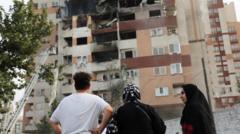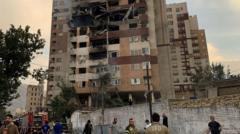On June 13, 2025, Israeli forces executed a high-stakes aerial assault on Iran, resulting in the deaths of several top Iranian generals and key nuclear scientists, alongside significant damage to Iran's military and nuclear capabilities, raising the stakes in the fraught regional landscape and igniting fears of further conflict.
Major Escalation: Israel's Strikes Devastate Iran's Military Leadership and Nuclear Infrastructure

Major Escalation: Israel's Strikes Devastate Iran's Military Leadership and Nuclear Infrastructure
In a shocking series of coordinated airstrikes, Israel targeted Iran's prominent military commanders and crucial nuclear facilities, dramatically altering the landscape of Middle Eastern geopolitics.
The article text follows below:
---
On Friday morning, June 13, 2025, Israel launched a historically significant military operation against Iran, targeting key military figures and nuclear facilities across the nation. The attack resulted in the deaths of top Iranian military leaders, including Maj. Gen. Mohammad Bagheri, the chief of staff, and Gen. Hossein Salami, commander of the Islamic Revolutionary Guards Corps, as confirmed by both Iranian state media and Israel’s military intelligence.
This unprecedented military action, amplified by over 200 Israeli warplanes, marks one of the largest strikes against Iran since its war with Iraq, aiming to dismantle Iran's military chain of command and disrupt its nuclear ambitions. Principal sites targeted in the strikes included the Natanz uranium enrichment facility, strategically crucial for fostering Iran's nuclear weapon capabilities, along with various military bases and mobile missile depots dispersed across the country from Tehran to Tabriz.
Amid this chaos, Iranian Supreme Leader Ayatollah Ali Khamenei acknowledged the attacks, pledging a "harsh punishment" for Israel and pledging to swiftly replace the lost officials, indicating the potential for instability and heightened military tensions in the region. The precise impact of the strike on Iran's nuclear capabilities remains in question, with experts emphasizing that damage to the Natanz site may not fully thwart Iran's ongoing nuclear advancements, particularly regarding its fortified Fordow facility.
Compounding the situation is former President Donald Trump's commentary following the attack, wherein he stated that Iran, having spurned diplomatic overtures, must negotiate a new nuclear deal before facing further violent consequences. Trump's remarks underscore the ongoing U.S.-Iran tensions and the potential ramifications for future negotiations regarding Iran's nuclear program.
As civilians in Tehran wonder about the escalating conflict, long queues formed at gas stations and grocery stores, reflecting a populace on alert for retaliatory measures from Iran, which has launched over 100 drones towards Israeli territory in the wake of the strikes. The political and military landscape in the region has been irrevocably altered, leading to growing uncertainty about the future and the likelihood of re-engaged hostilities.
This unforeseen military action not only represents a significant escalation within a historically contentious arena but also poses critical questions about the balance of power and the role of regional and international actors in shaping the future of Iran's nuclear capabilities and military strategies. As response strategies unfold, the ripple effects of these actions extend far beyond the immediate impact on Iran and Israel, influencing multinational diplomatic efforts and heightening tensions in an already volatile Middle East.
---
On Friday morning, June 13, 2025, Israel launched a historically significant military operation against Iran, targeting key military figures and nuclear facilities across the nation. The attack resulted in the deaths of top Iranian military leaders, including Maj. Gen. Mohammad Bagheri, the chief of staff, and Gen. Hossein Salami, commander of the Islamic Revolutionary Guards Corps, as confirmed by both Iranian state media and Israel’s military intelligence.
This unprecedented military action, amplified by over 200 Israeli warplanes, marks one of the largest strikes against Iran since its war with Iraq, aiming to dismantle Iran's military chain of command and disrupt its nuclear ambitions. Principal sites targeted in the strikes included the Natanz uranium enrichment facility, strategically crucial for fostering Iran's nuclear weapon capabilities, along with various military bases and mobile missile depots dispersed across the country from Tehran to Tabriz.
Amid this chaos, Iranian Supreme Leader Ayatollah Ali Khamenei acknowledged the attacks, pledging a "harsh punishment" for Israel and pledging to swiftly replace the lost officials, indicating the potential for instability and heightened military tensions in the region. The precise impact of the strike on Iran's nuclear capabilities remains in question, with experts emphasizing that damage to the Natanz site may not fully thwart Iran's ongoing nuclear advancements, particularly regarding its fortified Fordow facility.
Compounding the situation is former President Donald Trump's commentary following the attack, wherein he stated that Iran, having spurned diplomatic overtures, must negotiate a new nuclear deal before facing further violent consequences. Trump's remarks underscore the ongoing U.S.-Iran tensions and the potential ramifications for future negotiations regarding Iran's nuclear program.
As civilians in Tehran wonder about the escalating conflict, long queues formed at gas stations and grocery stores, reflecting a populace on alert for retaliatory measures from Iran, which has launched over 100 drones towards Israeli territory in the wake of the strikes. The political and military landscape in the region has been irrevocably altered, leading to growing uncertainty about the future and the likelihood of re-engaged hostilities.
This unforeseen military action not only represents a significant escalation within a historically contentious arena but also poses critical questions about the balance of power and the role of regional and international actors in shaping the future of Iran's nuclear capabilities and military strategies. As response strategies unfold, the ripple effects of these actions extend far beyond the immediate impact on Iran and Israel, influencing multinational diplomatic efforts and heightening tensions in an already volatile Middle East.




















